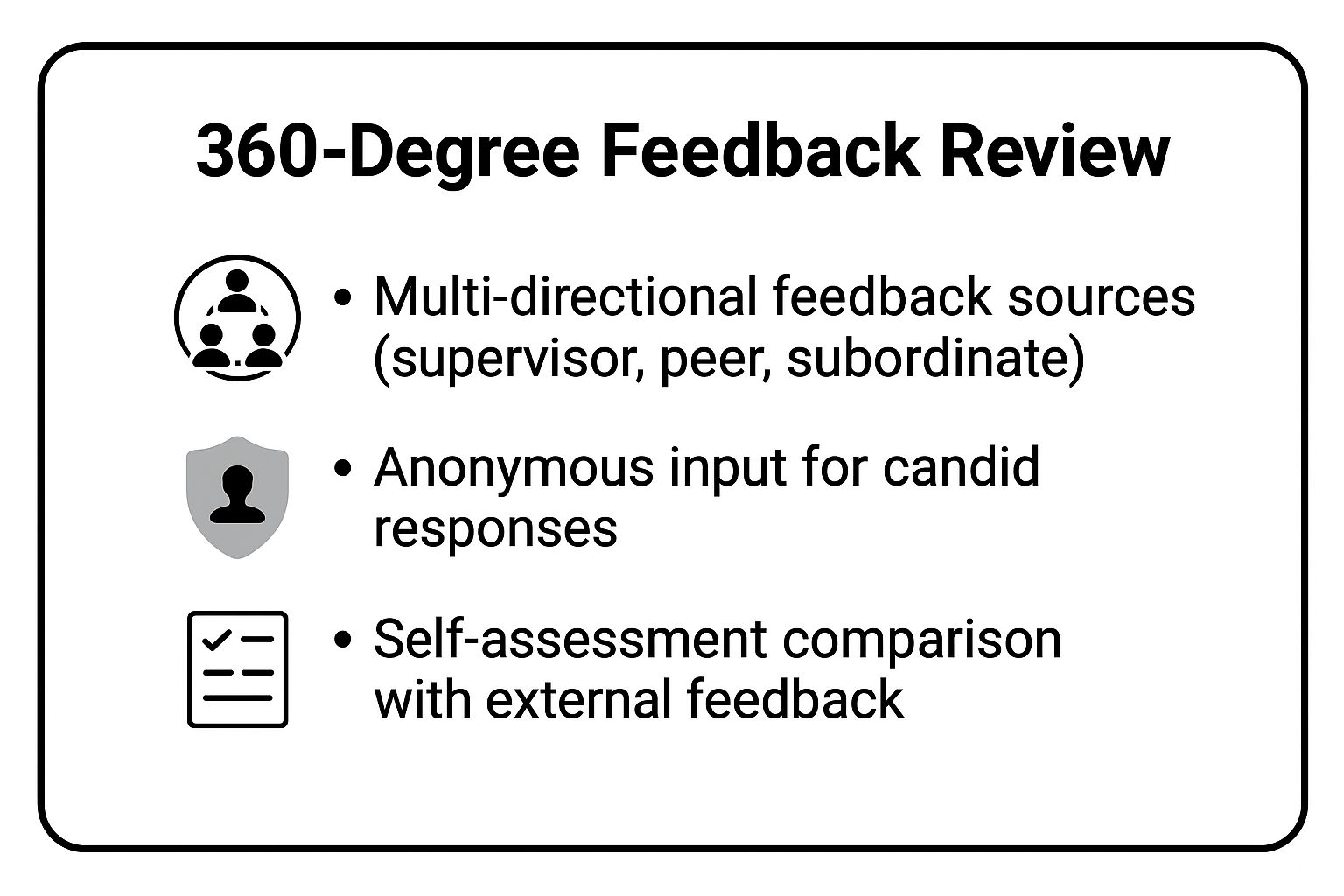Crafting effective, fair, and motivating employee reviews is a critical skill for any manager. The right phrasing can inspire growth and align individual efforts with organisational goals, while the wrong words can demotivate and disengage. This article moves beyond generic advice to provide a comprehensive toolkit of specific, actionable employee review examples. We will dissect various performance review models, offering precise language you can adapt for your own evaluation processes.
To begin understanding the various ways to conduct performance evaluations, you might find this guide on Top Performance Review Examples For Effective Feedback particularly helpful. It lays a solid foundation for the detailed frameworks we will explore.
Our focus is on providing practical, replicable phrases and structures that you can immediately apply. We will break down examples for different review types, including 360-degree feedback, strengths-based assessments, and competency-based evaluations. Each section offers strategic analysis and tactical insights to help you deliver feedback that is not only clear and constructive but also legally compliant and strategically sound. By the end of this guide, you will be better equipped to conduct performance appraisals that genuinely foster development and drive business success, moving from theory to confident, practical application.
1. The 360-Degree Feedback Review
The 360-degree feedback review is a comprehensive performance evaluation method that moves beyond the traditional top-down assessment. Instead of relying solely on a manager's perspective, this approach gathers anonymous input from an employee's entire professional circle: supervisors, peers, direct reports, and sometimes even external clients. This multi-source system provides a holistic, well-rounded view of an employee's performance, competencies, and impact on the organization.
By collecting diverse viewpoints, companies can uncover blind spots that a single manager might miss. This method is particularly powerful for leadership development, as it highlights how a manager's actions are perceived by their team versus their own superiors. Companies like Microsoft famously shifted from a competitive stack-ranking system to a more collaborative 360-degree feedback model to foster teamwork and holistic growth.
Why This Method is Effective
The primary benefit of a 360-degree review is its depth. It provides a balanced perspective, mitigating the potential for personal bias from a single reviewer. This comprehensive approach is one of the best employee review examples for developing self-awareness and pinpointing specific areas for professional growth.
Strategic Insight: The anonymity of 360-degree feedback is crucial. It encourages candid, honest responses that employees might otherwise hesitate to share, leading to more authentic and actionable insights.
The following infographic summarizes the core components that make this review process so effective.

This visual highlights how multi-directional, anonymous input is combined with self-reflection to create a complete performance picture.
Actionable Takeaways
To implement a successful 360-degree feedback process, focus on structure and communication.
- Train Participants: Teach all reviewers how to provide constructive, behavior-based feedback rather than making subjective personality judgments.
- Ensure Confidentiality: Use a trusted third-party platform or a secure internal system to guarantee anonymity and encourage honest participation.
- Create a Development Plan: The process should not end with the report. Use the feedback to create a tangible, forward-looking development plan with clear goals and support from a manager or coach.
2. Continuous Performance Management Review
The continuous performance management review moves away from the traditional, once-a-year evaluation. Instead, it fosters an ongoing dialogue between managers and employees through regular check-ins, real-time feedback, and dynamic goal-setting. This agile approach prioritises immediate course correction and continuous professional development over retrospective assessment.
This model transforms performance management from a stressful annual event into a fluid, integrated part of the work week. It allows teams to adapt quickly to changing business priorities and supports a culture of coaching rather than judging. Prominent examples include Adobe's celebrated "Check-In" system, which famously replaced its annual reviews to boost engagement and retention, and Accenture's "Performance Achievement" platform, which focuses on forward-looking conversations.
Why This Method is Effective
The core advantage of continuous performance management is its timeliness. By addressing challenges and celebrating achievements as they happen, managers can guide employee performance in real time, preventing small issues from becoming significant problems. This frequent interaction builds stronger, more trusting relationships and makes performance discussions a natural part of the workflow. These factors make it one of the most modern and effective employee review examples for fast-paced organisations.
Strategic Insight: The shift to a continuous model requires a fundamental change in mindset. Managers must evolve from being evaluators to coaches, focusing on strengths-based development and future potential rather than past mistakes.
The following visual breaks down the cyclical nature of this ongoing performance dialogue.

This image shows how ongoing planning, action, tracking, and reviewing create a dynamic and responsive performance cycle.
Actionable Takeaways
To successfully implement a continuous performance management system, organisations must provide a clear framework.
- Establish a Rhythm: Create a consistent schedule for check-ins (e.g., weekly or bi-weekly) and ensure managers and employees stick to it.
- Train Your Managers: Equip managers with essential coaching skills, teaching them how to ask powerful questions, listen actively, and provide balanced, constructive feedback.
- Leverage Technology: Use a performance management platform to document conversations, track progress against goals, and provide visibility for both employees and leadership. The system should support, not dictate, the conversation.
3. The Strengths-Based Performance Review
The strengths-based performance review shifts the traditional focus from correcting weaknesses to identifying, cultivating, and leveraging an employee's natural talents. Popularised by research from Gallup and thought leaders like Marcus Buckingham, this approach asserts that employees achieve peak performance when their roles are aligned with what they do best. Instead of trying to make everyone a well-rounded generalist, the goal is to build a team of exceptional specialists whose strengths complement one another.
This model fundamentally changes the conversation from "What are you doing wrong?" to "How can we enable you to use your best talents more often?". Companies like Facebook and Best Buy have famously adopted this philosophy, creating roles and projects that allow employees to operate within their zones of genius. The result is higher engagement, increased productivity, and greater job satisfaction.

This visual represents the core idea: focusing resources on amplifying natural talents leads to exponential growth, while focusing on weaknesses yields only marginal improvements.
Why This Method is Effective
The primary benefit of a strengths-based review is its positive, forward-looking orientation. It boosts employee morale and confidence by celebrating their innate abilities, which naturally fosters a more engaged and motivated workforce. This approach is one of the most powerful employee review examples for maximising individual and team potential.
Strategic Insight: Weaknesses are only addressed when they directly impede an employee's ability to apply their strengths. This pragmatic approach avoids wasting energy on fixing non-critical flaws and instead channels it toward high-impact development.
The focus on what's right with an employee rather than what's wrong transforms the review process from a dreaded critique into a collaborative strategy session for success.
Actionable Takeaways
To implement a strengths-based review system, focus on identification and strategic alignment.
- Use Assessment Tools: Employ validated tools like Gallup's CliftonStrengths to provide a common language and objective framework for identifying an employee's core talents.
- Create Strength-Focused Goals: Work with employees to set performance goals that directly utilise their top strengths. For example, a person with strong "Analytical" talents should be given data-heavy projects.
- Build Strength Partnerships: Encourage team members to recognise and lean on each other's strengths. Pair an employee strong in "Ideation" with one strong in "Execution" to bring innovative ideas to life.
4. OKR-Based Performance Review
An OKR-based performance review is a modern evaluation system built around Objectives and Key Results (OKRs). This method directly links an employee's performance to the achievement of specific, measurable objectives that are aligned with broader organisational goals. Instead of assessing a wide range of subjective behaviours, the focus is on tangible outcomes and contributions, fostering a results-driven culture.
The OKR framework, popularised by companies like Google and Intel, moves performance conversations from a retrospective critique to a forward-looking dialogue about impact. It encourages ambitious "stretch goals" that push employees and teams to innovate and achieve more than they thought possible. This makes it one of the most effective employee review examples for driving growth and aligning the entire organisation towards common targets.

Why This Method is Effective
The key benefit of an OKR-based review is its clarity and alignment. It removes ambiguity by defining exactly what success looks like for each role and how that success contributes to the company's strategic vision. This approach empowers employees by giving them clear ownership of their objectives and a direct line of sight into their impact. It is also highly adaptable, making it suitable for fast-paced environments like those at Spotify and Airbnb.
Strategic Insight: Separating OKR discussions from compensation reviews is critical, at least initially. This separation encourages employees to set ambitious goals without fear of financial penalty for "failing" to reach a stretch target, which fosters a culture of innovation and psychological safety.
The process creates a continuous feedback loop. Regular check-ins on OKR progress make performance management an ongoing conversation rather than a once-a-year event. This aligns well with measuring specific outcomes, such as those found in customer service key performance indicators. Learn more about how KPIs and OKRs can work together on cloud-call-center.ae.
Actionable Takeaways
To effectively implement an OKR-based performance review system, focus on disciplined execution and transparent communication.
- Limit the Focus: Start with a maximum of 3-5 high-impact objectives for each employee or team per cycle to avoid diluting effort.
- Define Measurable Results: Ensure every key result is quantifiable and time-bound. Vague KRs like "improve customer satisfaction" should be replaced with specifics like "increase NPS from 40 to 45 by Q4".
- Conduct Regular Check-ins: Implement weekly or bi-weekly check-ins to track progress, identify roadblocks, and adjust tactics. This keeps OKRs top-of-mind and prevents end-of-quarter surprises.
- Celebrate All Outcomes: Acknowledge and reward not just the achievement of goals but also the valuable lessons learned from ambitious attempts that fell short.
5. Competency-Based Performance Review
A competency-based performance review is a structured evaluation that measures an employee against a set of predefined skills, behaviours, and knowledge critical for success in their role. Rather than focusing solely on completed tasks or goals, this method assesses how an employee achieves their results. It provides a clear framework that links individual performance directly to organisational values and strategic objectives.
This approach defines what "good" looks like for each role, covering both technical skills (e.g., software proficiency) and soft skills (e.g., communication, leadership). For instance, companies like IBM and Procter & Gamble use deeply integrated competency models to ensure employees not only meet their targets but also embody the leadership and behavioural qualities the company values. This makes performance conversations more objective and development-focused.
Why This Method is Effective
The primary strength of a competency-based review is its clarity and objectivity. By establishing specific, measurable standards for behaviour, it removes ambiguity from the evaluation process and reduces the potential for manager bias. This is one of the most effective employee review examples for creating a consistent and fair system for assessment, development, and promotion across the entire organisation.
Strategic Insight: Link competencies directly to business outcomes. A well-designed competency for "Customer Focus" should not just describe positive interactions; it should include behaviours that demonstrably lead to higher customer satisfaction scores or retention rates.
This model provides a common language for performance, ensuring everyone from new hires to senior leaders understands the expectations for success and how to meet them.
Actionable Takeaways
To effectively implement a competency-based review system, a structured and deliberate approach is essential.
- Define Clear Competencies: Work with subject matter experts and leadership to identify and define the core competencies for different roles and levels. Provide clear behavioural examples for each proficiency level (e.g., "Developing," "Proficient," "Exemplary").
- Integrate into the Talent Lifecycle: Use the competency model for more than just reviews. Embed it into hiring processes, training programmes, and promotion criteria to create a cohesive talent management strategy.
- Train Managers and Employees: Ensure managers are trained to assess employees against these competencies accurately and provide specific, behaviour-based feedback. Employees should also understand the framework and how it applies to their career growth.
6. Peer Review Performance Evaluation
A peer review performance evaluation is a collaborative assessment method where colleagues at a similar organisational level evaluate each other's work, contributions, and professional behaviours. This approach moves away from a purely hierarchical review, leveraging the unique insights of those who work most closely with an employee on daily tasks and projects. It provides a ground-level view of teamwork, communication, and problem-solving skills in action.
This method is particularly valuable in team-oriented environments where collaboration is key to success. For instance, engineering teams often use code reviews as a form of peer assessment, while consulting firms rely on peer evaluations for project-based work. Companies like Amazon have incorporated peer feedback as a crucial component in their performance reviews to get a more complete picture of an employee's impact.
Why This Method is Effective
The strength of a peer review lies in its relevance and immediacy. Peers observe behaviours and contributions that managers might not see, such as informal leadership, willingness to help others, and day-to-day problem-solving. This makes it one of the most practical employee review examples for fostering a culture of mutual accountability and continuous improvement.
Strategic Insight: Peer reviews are most powerful when they are framed as a developmental tool, not a punitive one. Focusing on constructive, behaviour-based feedback helps build trust and encourages team members to support each other's growth.
This system creates a feedback loop that reinforces positive team dynamics and addresses interpersonal challenges before they escalate. It empowers employees to take ownership of their collective performance.
Actionable Takeaways
To implement an effective peer review system, a clear and supportive framework is essential.
- Establish Clear Guidelines: Provide structured forms and clear criteria for evaluation. Focus on objective, observable behaviours related to job roles and company values, not subjective personality traits.
- Provide Training: Equip employees with the necessary skills to deliver and receive feedback constructively. Our resources on customer service skills training can offer valuable communication techniques applicable here.
- Ensure Psychological Safety: Create an environment where employees feel safe to provide honest, candid feedback without fear of retaliation. Anonymity can be effective, but fostering a culture of trust is the ultimate goal.
- Balance the Input: Use peer feedback as one component of a larger evaluation. Combine it with a manager's assessment and a self-review to ensure a fair and balanced perspective.
7. Behavioural Anchored Rating Scale (BARS) Review
The Behavioural Anchored Rating Scale (BARS) is a sophisticated performance evaluation method that bridges the gap between qualitative feedback and quantitative metrics. It uses specific, observable workplace behaviours as "anchors" on a numerical rating scale. Instead of vague labels like "good" or "average," each point on the scale is defined by a concrete example of performance, reducing ambiguity and subjectivity.
This method provides exceptionally clear standards for what constitutes different levels of performance in a given role. It is heavily used in fields where objective measurement is critical, such as in police departments for officer evaluations or in healthcare organisations to assess clinical competence. The process of creating BARS involves input from both employees and managers, ensuring the behavioural examples are relevant and accurately reflect the job's demands.
Why This Method is Effective
The primary strength of BARS is its clarity and precision. By anchoring ratings to specific behaviours, it provides a common language for managers and employees to discuss performance, making feedback more direct and understandable. This approach is one of the best employee review examples for roles where specific actions directly correlate with success or failure.
Strategic Insight: The development of BARS itself is a valuable organisational exercise. It forces teams to define exactly what successful performance looks like in behavioural terms, leading to greater alignment and clearer expectations across the board.
The scale's design ensures that evaluations are based on observed actions rather than personal opinions or biases, leading to fairer and more defensible assessments. This detailed framework also makes it easier to pinpoint specific training needs.
Actionable Takeaways
To implement a BARS system effectively, a structured development process is essential.
- Use the Critical Incident Technique: Involve job incumbents and supervisors to identify specific examples (critical incidents) of both effective and ineffective job performance.
- Develop and Refine Scales: Group the incidents into key performance dimensions and use them to build the anchor points for each rating scale. Test the scales for clarity and relevance before full implementation.
- Provide Extensive Training: Train all managers and employees on how to use the scales correctly. This ensures consistent application and interpretation of the behavioural anchors. Effective contact centre quality assurance often relies on similar principles of specific, behaviour-based evaluation. You can learn more about how these detailed assessment frameworks are applied in customer-facing roles.
7 Employee Review Methods Comparison
| Performance Review Type | Implementation Complexity 🔄 | Resource Requirements ⚡ | Expected Outcomes 📊 | Ideal Use Cases 💡 | Key Advantages ⭐ |
|---|---|---|---|---|---|
| 360-Degree Feedback Review | High – multi-source, time-intensive | High – requires coordination and training | Holistic performance insight; identifies blind spots | Senior roles, leadership, team environments | Well-rounded perspective; accountability; leadership development |
| Continuous Performance Management | Moderate – ongoing process, structure needed | Moderate to High – frequent check-ins require manager time | Real-time feedback; continuous improvement; engagement boost | Fast-paced environments; teams needing agile feedback | Immediate problem-solving; stronger manager-employee relationship |
| Strengths-Based Performance Review | Moderate – focus on strengths assessment | Moderate – requires skill assessments and manager expertise | Increased engagement; confidence; effective teams | Roles suited to strength maximization; talent development | Builds on talents; enhances job satisfaction; effective teams |
| OKR-Based Performance Review | Moderate to High – quarterly cycles, alignment needed | Moderate – software tools recommended; goal-setting training | Clear alignment with company goals; measurable results | Goal-driven organizations; innovation-focused teams | Objective metrics; transparency; ambitious goal-setting |
| Competency-Based Performance Review | High – requires competency frameworks and training | High – model development and updates needed | Consistent evaluation; targeted development; succession planning | Structured roles; career pathing; technical and behavioral assessment | Clear expectations; reduces bias; supports promotion decisions |
| Peer Review Performance Evaluation | Moderate – structured but simpler than 360° | Moderate – peer training and feedback management | Insight into daily behaviors; team cohesion | Collaborative teams; flat organizations; project teams | Multiple viewpoints; reduces manager bias; improves collaboration |
| Behavioral Anchored Rating Scale (BARS) Review | Very High – intensive development, behavioral analysis | Very High – requires job analysis and ongoing maintenance | Accurate, consistent ratings; clear standards | Roles requiring objective, detailed performance measures (e.g. public sector, healthcare) | Reduces subjectivity; consistent evaluation; specific performance examples |
Final Thoughts
Navigating the landscape of employee performance reviews requires more than just a template; it demands a strategic approach tailored to your organisation's unique goals and culture. Throughout this guide, we have explored a diverse range of employee review examples, from the comprehensive 360-Degree Feedback model to the precise, data-driven OKR-Based Review. Each method offers a distinct lens through which to view and cultivate employee performance, moving beyond simple evaluation to genuine, impactful development.
The key takeaway is that the most effective performance reviews are not isolated events but part of a continuous, holistic strategy. The examples provided are not merely phrases to copy and paste. They are blueprints for constructing meaningful conversations that are specific, balanced, and forward-looking.
Core Principles for Effective Reviews
As you adapt these examples, remember the foundational principles that make any review successful:
- Specificity is Paramount: Vague feedback leads to ambiguous outcomes. Ground your comments in specific examples, data, and observable behaviours, as demonstrated in the BARS and OKR-based review sections.
- Balance is Essential: A great review balances constructive criticism with genuine recognition of strengths. The Strengths-Based Review model exemplifies this, showing how focusing on what an employee does well can be a powerful catalyst for growth.
- Future-Orientation Drives Growth: The goal is not just to critique past performance but to pave the path for future success. Every piece of feedback should be tied to actionable steps, development goals, and clear expectations for the road ahead.
By internalising these principles, you transform the performance review from a procedural chore into a cornerstone of your talent management strategy. The right employee review examples serve as a launchpad, empowering managers to foster a culture of continuous improvement, transparency, and mutual respect.
Your Actionable Next Steps
To truly master this process, move from theory to application. We encourage you to:
- Select a Model: Choose one or two review types from this article, like the Competency-Based or Continuous Performance model, that best align with your company's immediate needs.
- Customise the Phrases: Take the sample phrases and adapt them for a specific employee and situation. Focus on integrating concrete data and project-specific examples.
- Conduct a Pilot Review: Trial your new approach with a small, receptive team. Gather feedback from both managers and employees to refine the process before a company-wide rollout.
Ultimately, mastering the art of the employee review is an investment in your most valuable asset: your people. It's about building a framework that not only measures performance but also inspires potential, aligns individual efforts with organisational objectives, and reinforces the supportive, high-performance culture you aim to build. The effort you invest in crafting detailed, empathetic, and strategic reviews will pay dividends in employee engagement, retention, and overall business success.
To effectively track the goals and action items discussed in your performance reviews, a robust communication and collaboration platform is essential. Cloud Move provides a unified communications solution that helps managers and teams stay aligned, monitor progress on key objectives, and facilitate the continuous feedback loops vital for modern performance management. Discover how Cloud Move can support your performance strategy.




